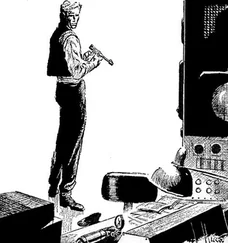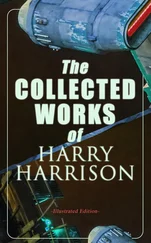Harry Harrison - The Turing Option
Здесь есть возможность читать онлайн «Harry Harrison - The Turing Option» весь текст электронной книги совершенно бесплатно (целиком полную версию без сокращений). В некоторых случаях можно слушать аудио, скачать через торрент в формате fb2 и присутствует краткое содержание. Год выпуска: 1992, ISBN: 1992, Издательство: Viking, Жанр: Фантастика и фэнтези, на английском языке. Описание произведения, (предисловие) а так же отзывы посетителей доступны на портале библиотеки ЛибКат.
- Название:The Turing Option
- Автор:
- Издательство:Viking
- Жанр:
- Год:1992
- ISBN:978-0-670-84528-6
- Рейтинг книги:3 / 5. Голосов: 1
-
Избранное:Добавить в избранное
- Отзывы:
-
Ваша оценка:
- 60
- 1
- 2
- 3
- 4
- 5
The Turing Option: краткое содержание, описание и аннотация
Предлагаем к чтению аннотацию, описание, краткое содержание или предисловие (зависит от того, что написал сам автор книги «The Turing Option»). Если вы не нашли необходимую информацию о книге — напишите в комментариях, мы постараемся отыскать её.
The Turing Option — читать онлайн бесплатно полную книгу (весь текст) целиком
Ниже представлен текст книги, разбитый по страницам. Система сохранения места последней прочитанной страницы, позволяет с удобством читать онлайн бесплатно книгу «The Turing Option», без необходимости каждый раз заново искать на чём Вы остановились. Поставьте закладку, и сможете в любой момент перейти на страницу, на которой закончили чтение.
Интервал:
Закладка:
As she talked she activated the connecting machine and instructed it to move over the open skull, told it to descend. When she did this the tiny, branching fingers slowly widened, spread apart, moved slowly downward. The computing capacity of the machine’s computer was so great that every single one of the microscopically fine fingers was separately controlled. The fingertips themselves did not contain the lenses, which needed a larger number of wavelengths of light to form an image. So the lenses themselves were a few branches back. The image from the lens on each finger was relayed back to the computer, where it was compared with the other images to build an internal three-dimensional model of the severed brain. Down the tendrils went again, some moving slower man the others until they were close to the surface, spread out and obscuring the surgeon’s view of the area.
Snaresbrook turned to the monitor screen, spoke to it.
“Lower. Stop. Lower. Tilt back. Stop.”
Now she had the same view as the computer. A close-up image of the severed surfaces that she could zoom in on — or move back to get an overall view.
“Begin the spray,” she ordered.
One in ten of the tendrils was hollow; in reality they were tiny tubes with electronic valves at the tip. The spray — it had to be a microscopically fine spray so small were the orifices — began to coat the surface of the severed brain. It was an invisible electrofluorescent coating.
“Turn down the theater lights,” she ordered, and the overall illumination dimmed.
The connection machine was satisfied with its work and had stopped spraying. After selecting the lowest area of the wound, Snaresbrook sent the tiniest amount of ultraviolet light down the hair-thin fiber optics.
On the screen a pattern of glowing pinpoints speckled the brain’s surface.
“The electroluminescent coating has now been sprayed onto all the nerve endings. Under UV light it emits enough photons to be identified. Only those nerves that are still alive cause the reaction that is activated by the UV. Next I will put the implants into place.”
The implants, specially manufactured to conform to the contours of the raw surfaces of Brian’s brain, were now in a tray in which they were immersed in a neutral solution. The tray was placed on the table next to Brain’s head and the cover removed. With infinitely delicate touch the tendrils dropped down into it.
“These PNEP implants are custom-made. Each consists of layers of films, flexible organic-polymer semiconductor arrays. Flexible and stretchable because the severed tissues of the brain will have changed slightly since they were measured for the manufacture of these chips. That is what is going to happen next. The chips appear to look identical, but of course they are not. The computer measured and designed each of them to fit precisely to a selected area of the exposed brain. Now it is able to recognize and match each of them to the correct area. Each film has several optical-fiber connecting links that will be attached to adjoining chips multiplexing in-out cross-communication signals between parts of the brain. If attention is directed to the upper surface of the films it will be seen that there is also an I-O wire on each of them. The importance of this will be explained at the next operation. This particular session will be completed when all ten thousand of the implants are in place. The process will now begin.”
Although Snaresbrook was there to supervise, it was the computer that controlled the implants, the fingers moving so fast that they blurred into invisibility. In flashing procession the thin-film chips were guided one after the other into place, until the last one was secure. The fingers withdrew and Snaresbrook felt some of the tension drain away. She straightened and realized that the pain in her back was sharp as a knife point. She ignored it.
“The next stage, the connecting process, has now begun. The film surfaces are a modification of active matrix display technology. The object is for each semiconductor, when activated by the luminescence, to identify a live nerve. Then to make a physical connection with that nerve. The films are coated with the correct growth hormones to cause the incoming nerve fibers to form synapses with the input transistors. The importance of these connections will be made manifest at the next implant procedure. Each dead distal fiber must be replaced by a fetal cell that is genetically engineered to grow a new axon inside the sheath of the cell it is replacing — then grow new synapses to replace the old, dying distal ones. At the same time as the fetal cells, dendrites will grow to contact the output pad on the film chip.”
The operation took almost ten hours. Snaresbrook was present the entire time.
When the last connection had been made the fatigue hit like a locomotive. She stumbled and had to clutch the door frame as she left the room. Brian required constant monitoring and attention after the operation — but the nursing staff could handle this.
The procedures to mend Brian’s brain were exhausting — yet she still had other patients and scheduled operations that had to be done. She rescheduled them, sought out and received the best assistance from the top surgeons, took only the most urgent cases. Yet she was still working a full twenty-four hours, had been for days. Her voice trembled as she made verbal notes on the procedure just finished. Her desk computer would record and transcribe them. Dexedrine would see her through the day. Not a good idea but she had little choice.
Finished, she yawned and stretched.
“End of report. Intercom on. Madeline.” The desk computer accepted the new command and bleeped the secretary.
“Yes, Doctor.”
“Send in Mrs. Delaney now.”
She rubbed her hands together and straightened her back. “Switch on and record as file titled Dolly Delaney,” she said, then checked to see that the tiny red indicator in the base of the desk light came on. The door opened and she smiled at the woman who hesitantly entered. “It was very good of you to come,” Snaresbrook said, smiling, standing slowly and indicating the chair on the other side of the desk. “Please make yourself comfortable, Mrs. Delaney.”
“Dolly, if you please, Doctor. Can you tell me how he is?” Her voice had a tight edge to it as though she was working hard to keep it under control as she spoke. A thin, sharp-eyed woman clutching her large handbag in her lap with both hands; a barrier before her.
“Absolutely no change, Dolly, not since I talked to you yesterday. He is alive and we must be grateful for that. But he has been gravely injured and it is going to be weeks, possibly months, before we will know the outcome of the procedures. That is why I need your help.”
“I’m not a nurse, Doctor. I don’t see what I can possibly do.” She straightened the purse on her lap, keeping the barrier in place. She was a good-looking woman — would have looked better if the corners of her mouth hadn’t turned down sharply. She had the appearance of a person the world had not been kind to and who resented it. “You say you need help — yet I don’t have any idea at all what has happened to Brian. Whoever called me simply said that there had been an accident in the laboratory. I had hoped that you would be able to tell me more. When will I be able to see him?”
“Just as soon as possible. But you must realize that Brian has suffered extensive cranial damage. Severe trauma of the white matter of his brain. There is — memory impairment. But he can be helped if I find a way to evoke enough of his early memories. That is why I need more information about your son…”
“Stepson,” she said firmly. “Patrick and I adopted him.”
“I didn’t know, I’m sorry.”
Читать дальшеИнтервал:
Закладка:
Похожие книги на «The Turing Option»
Представляем Вашему вниманию похожие книги на «The Turing Option» списком для выбора. Мы отобрали схожую по названию и смыслу литературу в надежде предоставить читателям больше вариантов отыскать новые, интересные, ещё непрочитанные произведения.
Обсуждение, отзывы о книге «The Turing Option» и просто собственные мнения читателей. Оставьте ваши комментарии, напишите, что Вы думаете о произведении, его смысле или главных героях. Укажите что конкретно понравилось, а что нет, и почему Вы так считаете.










